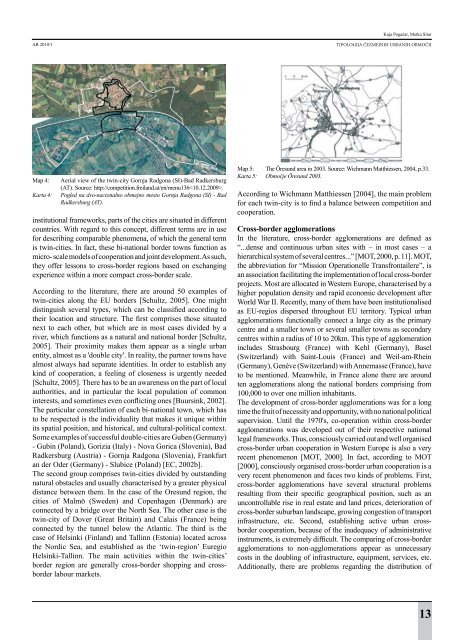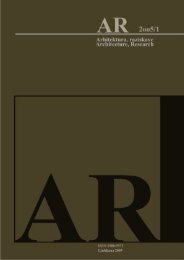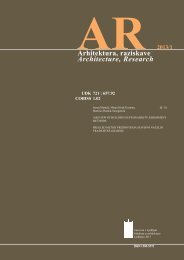AR 2010/1 - Fakulteta za arhitekturo - Univerza v Ljubljani
AR 2010/1 - Fakulteta za arhitekturo - Univerza v Ljubljani
AR 2010/1 - Fakulteta za arhitekturo - Univerza v Ljubljani
You also want an ePaper? Increase the reach of your titles
YUMPU automatically turns print PDFs into web optimized ePapers that Google loves.
Kaja Pogačar, Metka Sitar<br />
<strong>AR</strong> <strong>2010</strong>/1<br />
TIPOLOGIJA ČEZMEJNIH URBANIH OBMOČIJ<br />
Map 4:<br />
Karta 4:<br />
Aerial view of the twin-city Gornja Radgona (SI)-Bad Radkersburg<br />
(AT). Source: http://competition.freiland.at/en/menu136.<br />
Pogled na dvo-nacionalno obmejno mesto Gornja Radgona (SI) - Bad<br />
Radkersburg (AT).<br />
institutional frameworks, parts of the cities are situated in different<br />
countries. With regard to this concept, different terms are in use<br />
for describing comparable phenomena, of which the general term<br />
is twin-cities. In fact, these bi-national border towns function as<br />
micro- scale models of cooperation and joint development. As such,<br />
they offer lessons to cross-border regions based on exchanging<br />
experience within a more compact cross-border scale.<br />
According to the literature, there are around 50 examples of<br />
twin-cities along the EU borders [Schultz, 2005]. One might<br />
distinguish several types, which can be classified according to<br />
their location and structure. The first comprises those situated<br />
next to each other, but which are in most cases divided by a<br />
river, which functions as a natural and national border [Schultz,<br />
2005]. Their proximity makes them appear as a single urban<br />
entity, almost as a 'double city'. In reality, the partner towns have<br />
almost always had separate identities. In order to establish any<br />
kind of cooperation, a feeling of closeness is urgently needed<br />
[Schultz, 2005]. There has to be an awareness on the part of local<br />
authorities, and in particular the local population of common<br />
interests, and sometimes even conflicting ones [Buursink, 2002].<br />
The particular constellation of each bi-national town, which has<br />
to be respected is the individuality that makes it unique within<br />
its spatial position, and historical, and cultural-political context.<br />
Some examples of successful double-cities are Guben (Germany)<br />
- Gubin (Poland), Gorizia (Italy) - Nova Gorica (Slovenia), Bad<br />
Radkersburg (Austria) - Gornja Radgona (Slovenia), Frankfurt<br />
an der Oder (Germany) - Slubice (Poland) [EC, 2002b].<br />
The second group comprises twin-cities divided by outstanding<br />
natural obstacles and usually characterised by a greater physical<br />
distance between them. In the case of the Oresund region, the<br />
cities of Malmö (Sweden) and Copenhagen (Denmark) are<br />
connected by a bridge over the North Sea. The other case is the<br />
twin-city of Dover (Great Britain) and Calais (France) being<br />
connected by the tunnel below the Atlantic. The third is the<br />
case of Helsinki (Finland) and Tallinn (Estonia) located across<br />
the Nordic Sea, and established as the ‘twin-region’ Euregio<br />
Helsinki-Tallinn. The main activities within the twin-cities’<br />
border region are generally cross-border shopping and crossborder<br />
labour markets.<br />
Map 5: The Öresund area in 2003. Source: Wichmann Matthiessen, 2004, p.33.<br />
Karta 5: Območje Öresund 2003.<br />
According to Wichmann Matthiessen [2004], the main problem<br />
for each twin-city is to find a balance between competition and<br />
cooperation.<br />
Cross-border agglomerations<br />
In the literature, cross-border agglomerations are defined as<br />
“...dense and continuous urban sites with – in most cases – a<br />
hierarchical system of several centres...” [MOT, 2000, p. 11]. MOT,<br />
the abbreviation for “Mission Operationelle Transfrontailere”, is<br />
an association facilitating the implementation of local cross-border<br />
projects. Most are allocated in Western Europe, characterised by a<br />
higher population density and rapid economic development after<br />
World War II. Recently, many of them have been institutionalised<br />
as EU-regios dispersed throughout EU territory. Typical urban<br />
agglomerations functionally connect a large city as the primary<br />
centre and a smaller town or several smaller towns as secondary<br />
centres within a radius of 10 to 20km. This type of agglomeration<br />
includes Strasbourg (France) with Kehl (Germany), Basel<br />
(Switzerland) with Saint-Louis (France) and Weil-am-Rhein<br />
(Germany), Genève (Switzerland) with Annemasse (France), have<br />
to be mentioned. Meanwhile, in France alone there are around<br />
ten agglomerations along the national borders comprising from<br />
100,000 to over one million inhabitants.<br />
The development of cross-border agglomerations was for a long<br />
time the fruit of necessity and opportunity, with no national political<br />
supervision. Until the 1970's, co-operation within cross-border<br />
agglomerations was developed out of their respective national<br />
legal frameworks. Thus, consciously carried out and well organised<br />
cross-border urban cooperation in Western Europe is also a very<br />
recent phenomenon [MOT, 2000]. In fact, according to MOT<br />
[2000], consciously organised cross-border urban cooperation is a<br />
very recent phenomenon and faces two kinds of problems. First,<br />
cross-border agglomerations have several structural problems<br />
resulting from their specific geographical position, such as an<br />
uncontrollable rise in real estate and land prices, deterioration of<br />
cross-border suburban landscape, growing congestion of transport<br />
infrastructure, etc. Second, establishing active urban crossborder<br />
cooperation, because of the inadequacy of administrative<br />
instruments, is extremely difficult. The comparing of cross-border<br />
agglomerations to non-agglomerations appear as unnecessary<br />
costs in the doubling of infrastructure, equipment, services, etc.<br />
Additionally, there are problems regarding the distribution of<br />
13

















